Introduction
How to help wild rabbits in winter? Let’s find out.
Imagine fluffy tails, cute floppy ears, and a heartwarming mission to protect these delightful creatures during the coldest season of the year. I’m so excited to share with you some incredible strategies and tips to ensure the survival and well-being of our furry friends.
Picture this: a winter wonderland covered in a soft blanket of snow, the air crisp and cool. In the midst of this picturesque scene, our wild rabbits face a multitude of challenges.
But fear not, my fellow nature enthusiasts, for we hold the key to their survival!
We’re going to learn about creating wildlife corridors that connect habitats, allowing our adorable hoppers to thrive and find the resources they need. We’ll explore feeding strategies to keep their bellies full and their energy levels high during the harsh winter months.
But that’s not all! We’ll also discover how to provide warmth by creating cozy shelters and clearing pathways in the snow.
I can’t wait to dive into this adventure with you! Together, we’ll explore the magical world of wild rabbits, learn about their unique needs and behaviors, and uncover ways to make a real difference in their lives.
Are you with me? Let’s hop to it!
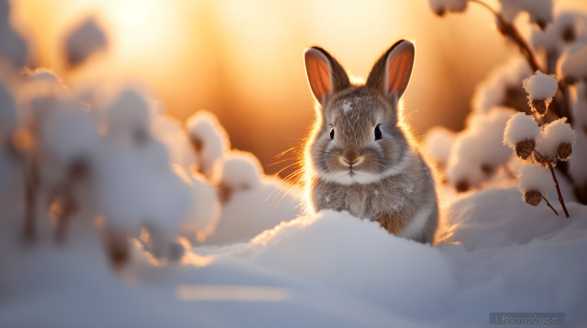
Key Takeaways
- Creating wildlife corridors connecting habitats is crucial for wild rabbits in winter, as it provides access to food, breeding opportunities, and protection from predators.
- To create wildlife corridors, enhance existing natural features, connect gardens, and collaborate with the community to establish protected green spaces.
- Feeding strategies for wild rabbits in winter include providing fiber-rich foods, leafy greens, fruits and vegetables, and high-quality pellets.
- Create feeding stations in various locations, provide shelter and cover, maintain a consistent feeding schedule, and ensure access to water sources.
- Managing water sources for wild rabbits involves using heated water bowls, insulated water bottles, natural dew collection, and regular cleaning of water sources.
- Natural foraging is vital for wild rabbits in winter, and incorporating grasses, weeds, wildflowers, and tree barks into their diet is crucial.
- Create an ideal habitat by planting a variety of vegetation, leaving some areas wild, and providing shelter for wild rabbits to encourage natural foraging behaviors.
- Clearing pathways for wild rabbits in winter is important for safety and ensuring access to food. Minimize disturbance, create narrow paths, avoid harmful chemicals, and maintain pathways during heavy snowfall.
- Build winter homes for wild rabbits using weather-resistant materials, insulation like hay or straw, and creating a suitable entrance.
- Protect wild rabbits from predators by creating dense vegetation, brush piles, burrows, and rabbit-friendly gardens. Use motion-activated lights, scent deterrents, noise-making devices, fencing, and provide supplemental support and intervention through feeding and water sources, and connecting with wildlife rehabilitators.
Creating Wildlife Corridors: Connecting Habitats for Wild Rabbits in Winter
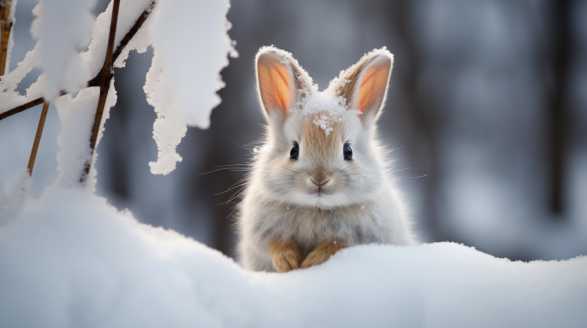
Hey there, fellow nature enthusiasts! Today, I want to talk about a subject that truly gets me hopping with excitement – creating wildlife corridors to connect habitats for wild rabbits in winter.
I’ll explore the importance of wildlife corridors, their benefits, and provide you with practical tips on how you can create these corridors in your own backyard or community.
Why are Wildlife Corridors Important for Wild Rabbits in Winter?
Wild rabbits, with their cute floppy ears and fluffy tails, often struggle to find enough food and shelter during the harsh winter months. Creating wildlife corridors allows these little hoppers to travel between habitats, accessing essential resources and avoiding predators along the way.
Benefits of Wildlife Corridors for Wild Rabbits
Let’s hop right into the many benefits of creating wildlife corridors for wild rabbits:
- Food Availability: Establishing connections between habitats means that wild rabbits can find a diverse range of food sources. This includes grasses, herbs, shrubs, and tree barks, without relying on a single location that might not sustain them through the winter.
- Breeding Opportunities: Wildlife corridors facilitate the movement of wild rabbits during their breeding season. By connecting different populations, we increase the chances of genetic diversity and reduce the risk of inbreeding, leading to healthier and stronger populations.
- Protection from Predators: Corridors act as a buffer against predators, giving wild rabbits a chance to escape when danger lurks nearby. They provide cover, allowing rabbits to move discreetly between habitats and decreasing the risk of being hunted.
- Survival in Extreme Weather: During harsh winter conditions, wild rabbits often struggle to find adequate shelter. Establishing wildlife corridors ensures that they have access to various resting spots, such as dense thickets, rabbit holes, and abandoned burrows, increasing their chances of survival.
How Can You Create Wildlife Corridors?
Creating wildlife corridors doesn’t have to be a daunting task. Here are some simple and effective ways you can make a difference:
Enhance Existing Natural Features
Look around your property or community and identify areas that can be enhanced to create a more rabbit-friendly environment. Consider the following:
- Plant native shrubs and trees that provide food and shelter for wild rabbits.
- Preserve and enhance existing meadows, grasslands, or forest edges to increase habitat availability.
- Maintain brush piles or create artificial ones where rabbits can seek refuge.
Connect Your Gardens
If you have a garden or a backyard, you can play a vital role in creating a seamless corridor for wild rabbits:
- Leave a section of your yard uncultivated to allow native grasses and wildflowers to grow, attracting rabbits.
- Create small gaps or access points in fences or hedges to enable rabbits to move freely between neighboring properties.
- Plant low-growing shrubs or install hedgerows along property boundaries to provide cover and additional food sources.
Collaborate with Your Community
By working together with your neighbors and local organizations, you can extend wildlife corridors beyond your own backyard:
- Coordinate with neighbors to create a larger corridor spanning multiple properties.
- Engage local conservation groups or schools to raise awareness and promote the importance of wildlife corridors.
- Lobby for the establishment of protected green spaces in your community that can serve as corridors between larger habitats.
Pave the Way with Water Sources
Water is a fundamental requirement for wild rabbits, and incorporating it into your wildlife corridors can make a significant difference:
- Install small, shallow water features like birdbaths, shallow pools, or small ponds to provide a hydration source for rabbits.
- Keep water sources accessible by ensuring they don’t freeze over during winter.
Creating wildlife corridors to connect habitats for wild rabbits in winter not only ensures their survival but adds a touch of nature’s magic to our lives. By enhancing natural features, connecting gardens, collaborating with our communities, and providing vital resources like food and water, we can make a positive impact on the lives of these adorable hoppers.
Together, we can create a network of wildlife corridors that bridges distances and boosts rabbit populations for generations to come. Happy wildlife corridor building!
Feeding Strategies: A Guide to Supporting Wild Rabbits in Winter

As winter sets in and the temperatures drop, it is essential to lend a helping hand to our furry friends in the wild. One species that often requires support during this challenging time is the wild rabbit.
I will guide you through some effective feeding strategies to support wild rabbits during the winter months.
Understanding the Challenges
Winter Survival for Wild Rabbits
Winter presents several significant challenges for rabbits in the wild. The scarcity of food due to frozen ground and barren vegetation, coupled with the increased energetic needs for thermoregulation, mean that rabbits must find creative ways to meet their nutritional requirements.
The Importance of Supplementary Feeding
While wild rabbits rely on their foraging skills, providing supplementary food can be crucial for their survival in winter. Such feeding strategies can help sustain their energy levels, prevent starvation, and ensure their overall well-being during this demanding season.
Choosing the Right Food
Fiber-rich Foods
When it comes to feeding wild rabbits, fiber is an essential component of their diet. Fiber helps promote healthy digestion and supports the physiological needs of these furry creatures.
- Timothy hay
- Orchard grass
- Meadow grass
Leafy Greens
Leafy greens are another vital source of nutrition for wild rabbits during winter. They offer essential vitamins and nutrients that contribute to their overall health and well-being.
- Kale
- Spinach
- Romaine lettuce
Fruits and Vegetables
While fruits and vegetables should be given sparingly, they can provide a valuable addition to wild rabbits’ diet during winter. These options can be a great source of hydration and essential vitamins for their survival.
- Carrots
- Apples
- Pears
Pellets
High-quality rabbit pellets should be included in their diet as a supplementary food source. Look for those with high fiber content and minimal additives.
Feeding Strategies
Locations for Feeding Stations
Creating feeding stations in various locations can increase access to food for wild rabbits and reduce competition among them. Choose areas that are sheltered from the wind, easily accessible, and safe from predators.
Provide Shelter and Cover
Ensure that the feeding stations are placed near suitable cover such as shrubs or bushes. This provides rabbits with protection against predators and also mimics their natural habitat.
- Brush piles
- Thick vegetation
- Dense shrubs
Consistency in Feeding
Establishing a regular feeding schedule helps wild rabbits anticipate when and where they can find food. This consistency reduces stress and allows them to allocate their energy more efficiently.
Food Placement
Spread the food out in multiple locations within the feeding station. This prevents crowding and allows all rabbits to have equal access to the provided nourishment.
Water Sources
While wild rabbits can source water from snow, ensuring a nearby water source can greatly benefit their hydration needs. Heated bird baths or shallow bowls of water can prevent dehydration, especially during dry and harsh winters.
Safety Considerations
Minimize Contact and Disturbance
When supporting wild rabbits during winter, it is essential to minimize direct contact and disturbance. Feeding stations should be designed to allow rabbits safe access without unnecessary human interaction.
Avoidance of Predation
Place feeding stations away from areas that may attract predators. By doing so, rabbits can feel safer while accessing their food source, reducing their vulnerability to predation.
Regular Monitoring
Maintain a routine of monitoring the feeding stations to ensure an adequate food supply and identify signs of distress or illness in wild rabbits. This timely intervention can be critical in supporting their well-being during winter.
By understanding the challenges faced by wild rabbits in winter and implementing effective feeding strategies, we can play a vital role in supporting their survival and well-being. By providing a varied and nutritious diet, creating suitable feeding stations, and considering their safety, we can make a significant impact on the lives of these remarkable creatures.
Managing Water Sources: Helping Wild Rabbits Stay Hydrated in Winter
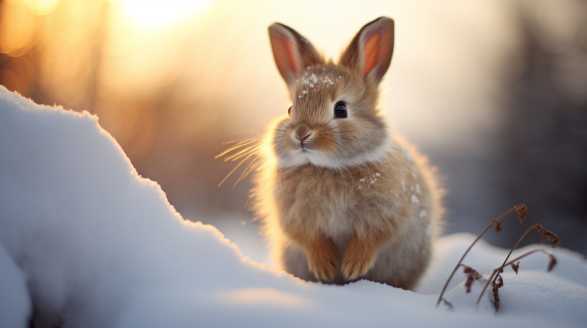
Hey there, fellow nature enthusiasts! Today, I want to shed some light on an important topic that often goes unnoticed – managing water sources for our furry friends, wild rabbits, during the winter season.
Join me as we explore simple yet effective ways to ensure their hydration needs are met during these cold months.
Importance of Hydration for Wild Rabbits
Before we dive into the specifics of managing water sources, let’s understand why hydration is crucial for our fluffy pals. Adequate water intake is vital for rabbits as it helps maintain their overall health and well-being.
During winter, when natural sources freeze or become inaccessible, rabbits often struggle to find water, leading to dehydration, illness, and even death. As compassionate nature lovers, it’s our responsibility to lend a helping hand!
Creating Accessible Water Sources
Now, let’s get into the nitty-gritty of managing water sources for wild rabbits in winter. Here are some practical tips to ensure they can quench their thirst:
1. Heated Water Bowls
Investing in heated water bowls can be a game-changer. These bowls are designed to prevent water from freezing, even in freezing temperatures.
2. Insulated Water Bottles
Insulated water bottles can also be a great option. Fill these with lukewarm water and secure them in a way that rabbits can easily access them.
3. Natural Dew Collection
Winter mornings often bring a magical touch with dewdrops glistening on grass and leaves. By positioning shallow dishes strategically, you can collect this natural dew as a water source for wild rabbits.
Ensuring Water Quality and Safety
Maintaining the quality and safety of water sources is as important as providing them. Here’s what you need to keep in mind:
1. Regular Cleaning
Regularly clean and sanitize water bowls or bottles to prevent the buildup of algae, bacteria, or other contaminants. This will ensure that rabbits have access to clean and safe drinking water.
2. Awareness of Potential Hazards
Be mindful of potential hazards around water sources. Avoid placing containers near harmful substances, such as chemicals or toxic plants.
Encouraging Natural Water Sources
While providing man-made water sources is crucial, encouraging rabbits to utilize natural sources can be beneficial too. Let’s explore some ways to promote their natural habits:
1. Utilizing Birch Bark
Birch trees have a unique property – their bark acts as a natural water container. By carefully detaching a piece of birch bark, you can create a mini-water dish for the rabbits.
You’ve created a natural water station they’ll love.
2. Ice Melting Techniques
Scout out for natural water sources near rabbit habitats, such as frozen ponds or small streams. To ensure rabbits can access these during winter, experiment with non-toxic ice melting techniques.
And there you have it, folks – a comprehensive guide to managing water sources for wild rabbits during the winter months. By implementing these simple yet effective tips, we can make a remarkable difference in their lives.
Remember, every small act of kindness matters!
Natural Foraging: Ensuring Wild Rabbits Find Food in Winter
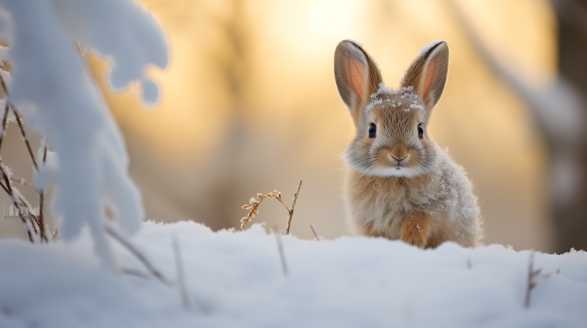
As a wildlife enthusiast, I have always been captivated by the agility and charm of wild rabbits. These adorable creatures are truly a delight to watch, but have you ever wondered how they manage to find enough food during the harsh winter months?
Understanding the Importance of Foraging
Foraging is an essential survival skill for wild rabbits, especially in winter when food sources become scarce. These agile little creatures rely on a diverse diet to stay healthy, and foraging allows them to find the necessary nutrients and energy they need to thrive.
A Balanced Diet for Wild Rabbits
To ensure wild rabbits stay healthy and meet their nutritional requirements, a well-rounded diet is crucial. Their natural diet consists of a variety of plants, grasses, and leaves.
- Grasses – Wild rabbits enjoy nibbling on a variety of grasses such as Timothy grass, Kentucky bluegrass, and fescue. These provide them with a good source of fiber.
- Weeds and Wildflowers – Dandelions, clover, plantain, and chickweed are just a few examples of weeds and wildflowers that wild rabbits love. These plants are rich in essential vitamins and minerals.
- Leafy Greens – Kale, spinach, and Swiss chard are excellent sources of nutrients and are perfect additions to a wild rabbit’s diet.
- Tree Barks and Twigs – Rabbits have strong teeth to gnaw on tree barks and twigs, which provide them with additional fiber and help keep their teeth from overgrowing.
Creating an Ideal Habitat
Now that we know what wild rabbits like to forage, it’s important to create an ideal habitat to encourage their foraging behaviors. Here are some tips to transform your garden into a bunny-friendly haven:
- Plant a Variety of Vegetation – Incorporate a diverse range of native plants, grasses, and shrubs in your garden. This will provide wild rabbits with an abundant supply of forage options.
- Leave Some Wild Areas – Allow a small portion of your garden to grow wild. Wild rabbits are attracted to areas with thickets, tall grasses, and shrubs, as it provides cover from predators.
- Provide Shelter – Create small shelters in your garden using plants, rocks, or even old logs. These hiding spots will encourage wild rabbits to explore and forage in your garden.
Supplementary Feeding Tips
While wild rabbits are adept at foraging for their food, providing supplementary feeding options can be beneficial, especially during harsh winters. Here are some ways you can offer additional food sources to help wild rabbits during challenging times:
Bird Feeders
Hang bird feeders with seeds and nuts at a height that wild rabbits can reach. This will offer them an alternative food source when their natural foraging options are limited.
Hay Piles
Place hay piles in your garden to mimic natural grassy areas. These piles of hay will attract wild rabbits and provide them with an easy and accessible source of food.
Winter Vegetables
Consider planting winter vegetables like carrots and Brussels sprouts. These vegetables will not only provide nourishment to wild rabbits but also add beauty and color to your garden.
Fresh Water
During winter, it’s crucial to ensure wild rabbits have access to fresh water. Consider placing shallow dishes or bowls filled with fresh water around your garden.
Observing With Wonder
Now that you have created an inviting habitat and provided supplementary feeding options, take some time to observe the wild rabbits in your garden. The joy of watching these graceful creatures as they happily forage for their food in winter is truly mesmerizing.
Ensuring wild rabbits find food in winter is a noble endeavor. By understanding their dietary needs, creating a suitable habitat, and offering supplementary feeding options, we can help these adorable creatures thrive during the colder months.
Providing Warmth: Tips for Preventing Hypothermia in Wild Rabbits
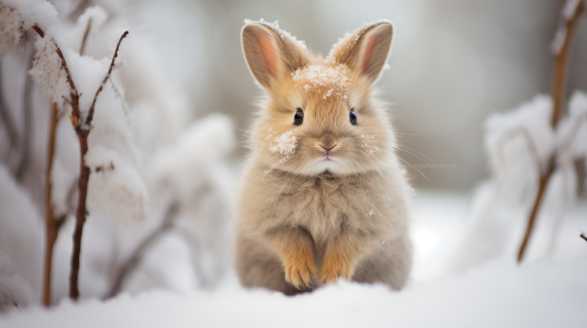
If you’ve ever come across a chilly little wild rabbit, you know how heartbreaking it can be to see them shivering in the cold. It’s important for us to step in and lend a helping hand by providing warmth to these precious creatures.
Let’s dive right in!
Understanding Hypothermia in Wild Rabbits
Before we begin, it’s crucial to grasp what hypothermia really means for our furry friends. Hypothermia occurs when a rabbit’s body temperature drops below the normal range of 101 to 103 degrees Fahrenheit.
Signs of Hypothermia
- Shivering
- Slow and shallow breathing
- Weakness or lethargy
- Cold and pale ears
- Decreased activity and mobility
- Loss of appetite
Providing Warmth – The Basics
When you encounter a wild rabbit suffering from hypothermia, follow these general steps to ensure their warmth and safety.
- Find a warm and quiet spot: Look for a secluded area away from loud noises and potential predators.
- Handle with care: Approach the rabbit gently to avoid causing any additional stress.
- Protect yourself: Wear gloves to prevent transferring your body heat too quickly, which can shock the rabbit’s system.
Strategies to Warm Up a Cold Rabbit
Now that you’ve established a comfortable environment, let’s explore some effective warming techniques to assist the rabbit in regaining their body heat.
1. Warm Water Bottle
- Fill a hot water bottle or a sealable plastic bottle with warm (not hot!) water.
- Wrap the bottle in a towel or soft cloth to create a cozy surface.
- Place the wrapped bottle beside or underneath the rabbit, allowing them to snuggle up to the warmth.
2. Heat Pad or Blanket
- Use a microwaveable heat pad or place a heating pad on a low setting.
- Wrap the pad in a soft blanket, ensuring the rabbit has enough space to move away if they get too warm.
- Place the wrapped pad beside or underneath the rabbit, allowing them to snuggle up.
3. Hot Water Method
- Fill a bowl or bottle with warm (not hot!) water.
- Wrap the container in a towel or cloth to avoid direct contact.
- Place the wrapped container near the rabbit, but ensure it is clear to freely move around.
4. Hay Bedding
- Create a cozy nesting area using clean and dry hay.
- Line a box or a container with the hay, making sure it is deep enough to provide insulation.
- Gently place the rabbit inside the bedding, allowing them to burrow and warm up naturally.
Seeking Professional Help
Sometimes, despite our best efforts, a wild rabbit may require professional assistance. It’s crucial to recognize when a situation demands expert care.
The rabbit’s condition worsens:
- Despite warming attempts, the rabbit’s body temperature continues to decrease.
- They display other alarming symptoms such as disorientation, seizures, or labored breathing.
You’re unsure of their condition:
- If you’re not experienced in handling wild rabbits, it’s best to consult with an expert to determine the best course of action.
Remember, these professionals have the knowledge and resources to provide the necessary care that wild rabbits need.
You’ve done an amazing job in learning how to prevent hypothermia in wild rabbits! By providing warmth and comfort, you’re giving these adorable creatures a chance to survive and thrive.
Together, we can make a positive impact on their lives and create a warm world for these precious animals. Stay warm and wild!
Safe Snow Removal: Clearing Pathways for Wild Rabbits in Winter
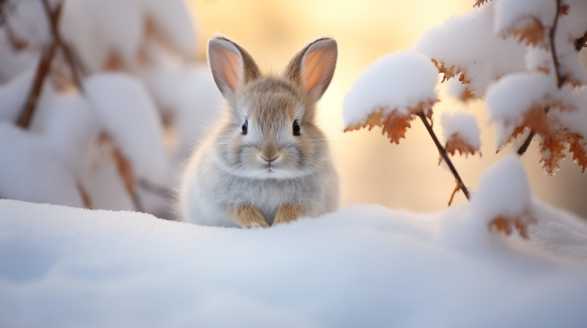
As an animal lover and enthusiast, I have always been fascinated by the ways in which we can coexist with wildlife, even in the harshest of winter conditions. One particular species that captures my attention is the wild rabbit.
I will share my knowledge and insights on how we can ensure the safety and well-being of wild rabbits during the winter season.
The Importance of Clearing Pathways for Wild Rabbits
Winter can be a challenging time for wild rabbits as they rely on vegetation for survival. With snow covering the ground, their access to food becomes limited, and navigating through deep snow can be exhausting for these small animals.
Why Snow Removal Matters
- #### Safety:
- By clearing pathways, we eliminate potential hazards such as hidden obstacles or dangers under the snow that could harm the rabbits.
- It also reduces the risk of rabbits getting stuck in deep or frozen snow, which can be fatal for them.
- #### Accessibility to Food:
- Wild rabbits primarily rely on leafy greens and bark during the winter when their regular food sources are scarce.
- Clearing pathways near shrubs and low hanging trees allows rabbits to reach these food sources more easily.
- #### Promoting Natural Behaviors:
- Rabbits are known for their hopping and running abilities. Clearing pathways enables them to maintain their natural movement patterns, preventing them from feeling too confined or restricted.
Safe Snow Removal Techniques
To make sure our snow removal efforts are effective and beneficial for wild rabbits, we need to follow certain guidelines. Here are some techniques to keep in mind:
- #### Start with a Plan:
- Before grabbing your shovel, take a few moments to observe the rabbit’s typical trails and patterns in your area.
- Identify areas where rabbits tend to forage or seek shelter. These are the pathways you should prioritize clearing.
- #### Minimize Disturbance:
- When clearing snow, try to disturb the rabbit’s habitat as little as possible.
- Remove snow gently and avoid making loud noises that might frighten or startle them.
- #### Create Narrow Paths:
- While we might be tempted to clear wide open areas, rabbits prefer narrow paths that mimic their natural movement patterns.
- Aim for pathways that are approximately 6-8 inches wide, allowing rabbits to navigate comfortably.
- #### Avoid Chemicals:
- Many snow removal products contain harmful chemicals that could be toxic to wildlife, including rabbits.
- Opt for environmentally-friendly alternatives, such as using sand or kitty litter for traction.
- #### Be Mindful of Surrounding Vegetation:
- It’s important to clear pathways while also being cautious not to damage any vegetation that rabbits rely on for food.
- Gently brush away snow from plants, rather than forcefully shoveling it.
- #### Maintain Pathways During Heavy Snowfall:
- Regularly check and maintain cleared pathways, especially during heavy snowfall.
- It ensures that wild rabbits have continuous access to food and safe routes to move around.
Benefits of Clearing Pathways
By going the extra mile to clear pathways for wild rabbits in winter, we bring about numerous benefits for both the rabbits and ourselves. These include:
- #### Conservation:
- By helping wild rabbits survive during the winter season, we contribute to the conservation of the species.
- Ensuring their well-being is crucial, as rabbits play an essential role in the ecosystem through their grazing and seed dispersal habits.
- #### Wildlife Observation:
- Creating pathways allows us to observe and appreciate the beauty of wild rabbits in their natural habitat.
- Get your binoculars ready for some fascinating wildlife sightings right in your backyard!
- #### Emotional Satisfaction:
- Knowing that our efforts have made a positive difference in the lives of these vulnerable creatures brings a sense of fulfillment and joy.
Clearing pathways for wild rabbits during the winter season is a small yet significant act of kindness that can make a world of difference for these adorable creatures. By following the safe snow removal techniques and guidelines shared in this article, we can create a safe haven for rabbits and ensure their survival in harsh winter conditions.
Providing Shelter: How to Build Winter Homes for Wild Rabbits
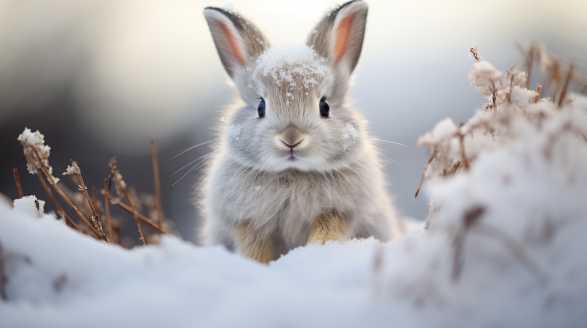
Winter can be a challenging time for our furry friends in the wild, especially for small creatures like rabbits. As temperatures drop and snow covers the ground, finding a safe and warm shelter becomes crucial for their survival.
So, let’s dive in and learn how to create cozy accommodations that will protect these adorable creatures during the cold winter months.
Understanding the Needs of Wild Rabbits
Before we jump into the construction process, it’s essential to understand the basic requirements of wild rabbits when it comes to shelter. These furry creatures need a protective structure that offers insulation, keeps them dry, and shields them from harsh weather conditions.
- Size: The shelter should be large enough to accommodate several rabbits comfortably.
- Materials: Choose durable and weather-resistant materials, such as wood or heavy-duty plastic.
- Location: Find a suitable location that is away from predators and well-drained to avoid flooding.
- Insulation: Ensure the shelter provides good insulation by using layers of hay or straw.
- Ventilation: Proper ventilation is crucial to prevent moisture buildup and the growth of mold or mildew.
Materials and Tools You’ll Need
To begin constructing the winter home for wild rabbits, gather the following materials and tools:
- Weather-resistant plywood
- Wooden boards
- Insulation materials (hay or straw)
- Nails and screws
- Hammer and screwdriver
- Saw
- Measuring tape
- Marker or pencil
- Gloves (for protection)
- Safety goggles (for eye protection)
Building a Basic Rabbit Shelter
Here, I will explain a simple yet effective way to build a rabbit shelter that can withstand the winter weather. Follow these step-by-step instructions:
Step 1: Preparing the Shelter Base
Start by measuring and marking the dimensions of your shelter. For example, a basic rabbit shelter could be approximately 3 feet in length, 2 feet in width, and 2 feet in height.
Step 2: Assembling the Shelter
Next, assemble the shelter by attaching the pieces together. Use nails or screws to secure the wooden boards to the base, creating the frame of the shelter.
Step 3: Adding Insulation
Now it’s time to add insulation to keep the rabbits warm and cozy. Line the inside of the shelter with hay or straw, creating a thick layer in all corners and along the walls.
Step 4: Creating an Entrance
To allow the rabbits easy access, cut a small entrance in one of the sides of the shelter. Make sure it’s just big enough for the rabbits to enter comfortably but small enough to prevent larger predators from getting inside.
Enhancing the Shelter
While the basic shelter provides adequate protection, there are a few additional enhancements you can make to create an even better winter home for wild rabbits:
- Waterproofing: Apply a weatherproofing sealant or paint to the exterior of the shelter to prevent water from seeping in.
- Elevating the Shelter: Placing the shelter on wooden pallets or bricks can help keep it off the ground and avoid moisture buildup.
- Covering the Entrance: A small piece of durable plastic or thick cloth can be used to cover the entrance, providing extra insulation during severe weather conditions.
- Extra Insulation: Consider adding extra layers of insulation inside the shelter during extremely cold weather or using insulated blankets.
As the winter season arrives, it’s crucial to provide wild rabbits with suitable shelters to ensure their survival. By following the steps outlined in this article and considering the needs of these adorable creatures, you can construct a cozy winter home that will protect them from the harsh elements.
Dealing with Predators: Strategies to Protect Wild Rabbits in Winter
As a wildlife enthusiast and conservationist, I understand the challenges that wild rabbits face during the harsh winter months. Predators lurk around every corner, ready to prey on these innocent creatures.
Understanding the Predators
Before diving into effective strategies, it is crucial to familiarize ourselves with the common predators that target wild rabbits. Knowing their habits and characteristics allows us to develop a better defense plan.
- ### The Cunning Fox
Foxes are notorious for their intelligence and hunting skills. They are agile and possess keen senses, making them formidable predators for wild rabbits.
- ### Refined Hunters: Coyotes
Coyotes are known for their adaptability, making them successful hunters in various environments. They are quick, agile, and often hunt in packs, increasing the challenge for unsuspecting rabbits.
- ### The Stealthy Feline: Bobcats
Bobcats are stealthy predators that possess incredible patience and agility. With their razor-sharp claws and powerful pounce, they pose a serious threat to wild rabbits.
Creating Safe Havens
Creating safe havens for wild rabbits is essential to protect them from predators during the harsh winter season. Here are some strategies to consider:
- ### Dense Vegetation
Wild rabbits thrive in areas with dense vegetation, such as thickets and shrubbery. These provide natural hiding places and make it difficult for predators to spot them.
- ### Brush Piles
Building brush piles in your backyard or nearby rabbit habitats can offer protection from predators. These piles create instant shelters where rabbits can seek refuge.
- ### Burrows
Wild rabbits are experts in burrow construction. By providing suitable areas with loose soil or sandy terrain, you can encourage them to create their own burrows for protection.
- ### Rabbit-Friendly Gardens
Designing your garden with wild rabbits in mind can benefit these creatures while deterring predators. Use tall, dense plants as natural barriers, and avoid using chemicals that may harm rabbits or disrupt their prey-predator relationships.
Predator Deterrents
Preventing predators from reaching the wild rabbits further enhances their chances of survival. Here are some effective deterrents to consider:
- ### Motion-Activated Lights
Installing motion-activated lights in rabbit habitats or areas where predators frequently visit can deter them from getting too close. Predators are often startled by sudden bright lights, giving rabbits a chance to escape.
- ### Repellents and Scented Deterrents
Certain scents and repellents can deter predators from approaching rabbit habitats. Natural options like coyote urine or essential oils such as peppermint, garlic, or clove can create a barrier that predators find repulsive.
- ### Noise-Making Devices
Predators often rely on stealth to catch their prey. By strategically placing noise-making devices, such as wind chimes or bells, near potential rabbit hiding spots, you can startle predators and buy the rabbits precious time to escape.
- ### Fencing and Barriers
Erecting appropriate fences around rabbit habitats or rabbit-friendly gardens can provide an extra layer of protection. Ensure that the fencing is buried at least six inches underground to prevent predators from digging their way in.
Human Intervention and Support
As advocates for the protection of wildlife, we can contribute to the survival of wild rabbits by providing supplementary support and intervention. Here are some human-driven strategies to consider:
- ### Supplemental Winter Feeding
During winter, food sources become scarce for wild rabbits. By offering supplemental feeding stations with hay, fresh vegetables, or specialized rabbit feed, we can ensure they have enough nourishment to survive harsh conditions.
- ### Water Sources
In winter, finding water can be a challenge for wild rabbits. By providing a shallow water source, such as a birdbath or low container, you can help them stay hydrated even in freezing temperatures.
- ### Proactive Wildlife Rehabilitation
Injured or orphaned wild rabbits require specialized care. Connecting with local wildlife rehabilitators helps ensure they receive proper treatment and have a chance to return to the wild.
Protecting wild rabbits from predators during winter is a noble effort that contributes to preserving the delicate balance of our ecosystems. By understanding predators’ behavior, creating safe havens, implementing deterrents, and providing supplementary support, we can make a significant difference in the survival of these adorable creatures.
Conclusion
Wow, what a wild ride it’s been exploring the world of wild rabbits in winter! We’ve hopped through the snow, built cozy shelters, cleared pathways, and protected our adorable furry friends from predators.
Creating wildlife corridors to connect habitats not only ensures their survival, but it adds a touch of magic to our surroundings. By collaborating with our community, enhancing natural features, and connecting gardens, we can create a network of safe passages for wild rabbits to thrive and flourish.
Feeding strategies have shown us that providing a balanced diet, creating feeding stations, and ensuring access to water sources can make all the difference for these little hoppers during the harsh winter months. It warms my heart to know we can nourish their bodies and souls with love and care.
Managing water sources and clearing pathways seem like small tasks, but they have a colossal impact on the lives of wild rabbits. By ensuring their hydration and safety, we give them the freedom to explore and forage with ease.
And let’s not forget about building winter homes and protecting wild rabbits from predators. By providing warmth and shelter, we give them a fighting chance against the elements.
As we conclude this enchanting journey, I am filled with gratitude and a renewed sense of purpose. We have learned so much about the unique needs and behaviors of wild rabbits, and we have discovered practical ways to make a real difference in their lives.
Let’s keep their fluffy tails wagging and their cute floppy ears bouncing with joy.
Frequently Asked Questions
How can I help wild rabbits survive in winter?
- Provide shelter: Build or put out nest boxes or small shelters filled with straw or hay to provide insulation and protection from the cold weather.
- Offer food: Place fresh vegetables, hay, and rabbit-friendly food near their shelter so they can easily access it.
- Provide water: Ensure that they have a constant supply of fresh water by placing a shallow dish or heated water bowl near their shelter.
- Avoid disturbance: Minimize disturbances around their habitat to reduce stress and conserve their energy.
- Avoid chemical use: Refrain from using harmful chemicals or pesticides in their vicinity to protect their health.
- Insulate their shelter: If possible, insulate their shelter from drafts and provide additional warm bedding material like blankets or towels.
- Create windbreaks: Erect physical barriers or plant dense vegetation around their habitat to minimize the impact of cold winds.
What should I feed wild rabbits in the winter?
Offer wild rabbits a varied and well-balanced diet consisting of fresh vegetables like kale, collard greens, and lettuce. Additionally, provide them with grass hay, orchard grass, or timothy hay as these are essential for their digestion and dental health.
Can I bring a wild rabbit indoors during winter?
It is generally not recommended to bring a wild rabbit indoors during winter, as they are adapted to surviving in the wild. The sudden change in environment and diet can cause significant stress and health problems for the rabbit.
How do wild rabbits stay warm in winter?
Wild rabbits have several mechanisms to stay warm during winter, including:
- Growing thicker fur: They develop a dense winter coat during colder months, which provides better insulation.
- Nesting: They burrow in thick vegetation or create shallow nests lined with their fur to keep warm.
- Huddling: Rabbits often gather together in groups for warmth, sharing body heat.
- Reducing activity: They conserve energy by limiting their movement and staying hidden during the coldest parts of the day.
Should I provide bedding for wild rabbits in winter?
While it is not necessary to provide bedding specifically for wild rabbits in winter, you can create a cozy environment for them by placing soft materials like straw or hay in their shelter or nesting boxes. These materials can provide additional insulation and comfort, helping them stay warm during colder weather.
Can I feed wild rabbits in my garden during winter?
Feeding wild rabbits in your garden during winter can be a thoughtful gesture, but it is important to do so responsibly. Avoid feeding them foods that could be harmful or detrimental to their health, such as bread or processed human food.
Are there any dangers for wild rabbits in winter?
Yes, there are potential dangers for wild rabbits in winter. Some common hazards include extreme cold, lack of food and water, predators, and human disturbances. By creating suitable shelters, providing food and water sources, minimizing disturbance, and taking other necessary precautions, you can help mitigate these risks and support the survival of wild rabbits during winter.

Why do Rabbits Poop So Much
Introduction Why do rabbits poop so much? Picture this: fluffy bunnies hopping around, so cute and adorable. But have you ever wondered why these furry creatures seem to be pooping machines? Well, my curious friends, I am here to unravel the mysteries and reveal the secrets behind a rabbit’s frequent pooping habits. From their unique […]

All About Rabbit Colonies
Introduction As a self-proclaimed animal enthusiast, I’ve spent countless hours observing and studying the incredible world of wildlife. But today, I’m thrilled to look into one of my absolute favorite creatures of all time – the wild rabbit! Picture this: lush green fields, a gentle breeze, and a community of wild rabbits scurrying about with […]

Why Do Rabbits Bite Your Clothes
Introduction Hey there, rabbit owners! We know how delightful it is to have these fluffy creatures hopping around our homes. Can you relate? Don’t worry, we’ve got your back! we’re diving into the fascinating world of rabbit behavior and tackling the topic of fabric chewing head-on. We’ll explore the reasons behind why rabbits have a […]

Can Rabbits Get Sick
Introduction Hey there, rabbit owners and enthusiasts! Are you ready to dive into the world of rabbit health and care? As a proud rabbit owner myself, I understand the love and concern we have for our furry companions. We want nothing but the best for them, right? we’ll be covering a range of topics related […]

Do Rabbits Have Paw Pads
Introduction Do rabbits have paw pads? You’re about to find out. Picture this: you’re sitting in your garden, watching a rabbit hop gracefully across the grass. It effortlessly moves through the terrain, avoiding obstacles with precision and ease. Those paw pads, my friends, are like the unsung heroes of the rabbit kingdom – soft, sensitive, […]
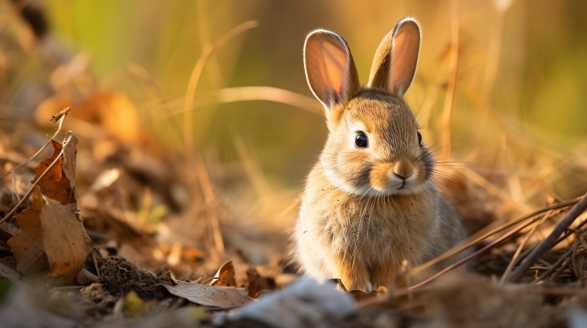
Do Rabbits Have Periods
Introduction Do rabbits have periods? Let’s find out. Get ready to have your curiosity piqued and your mind blown! Picture this: a world where fluffiness meets fertility, where hopping creatures mysteriously navigate their menstrual cycles. As a nature lover and self-proclaimed rabbit connoisseur, I confess that I, too, was initially taken aback by the concept […]
